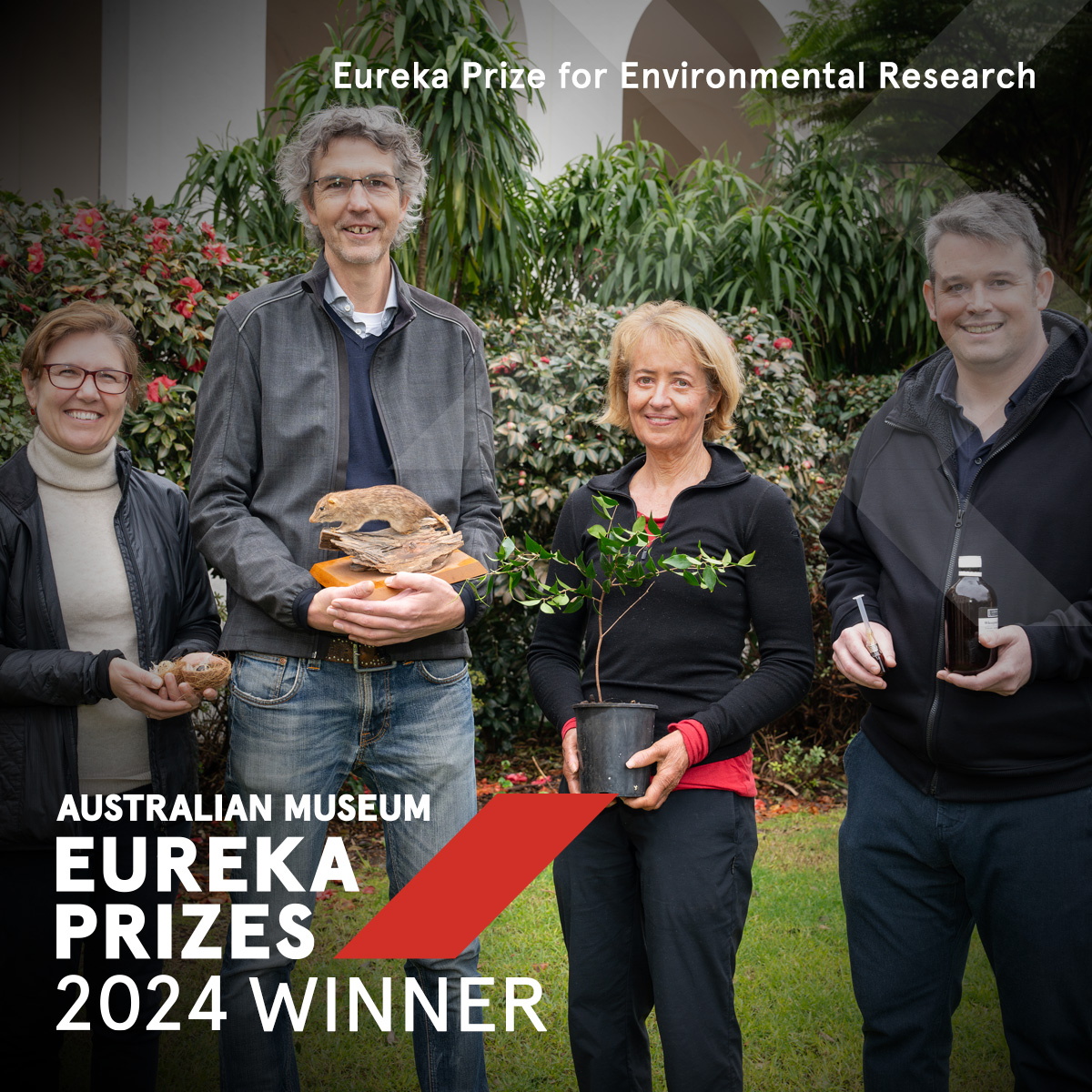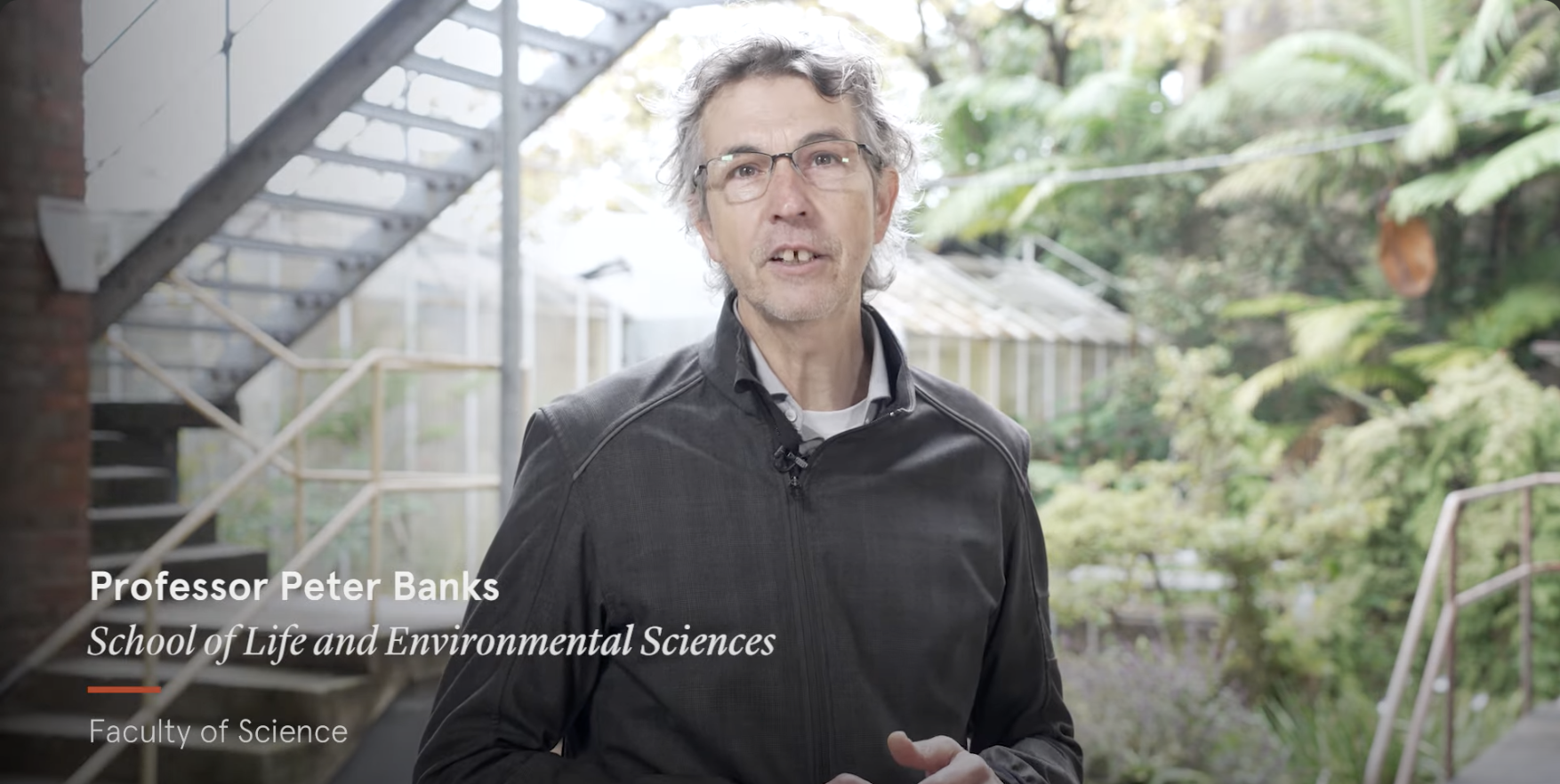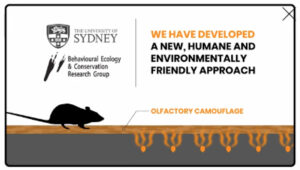Our research
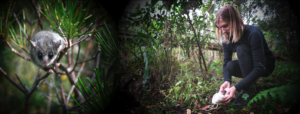
Our research
The work of the Sensory Conservation Team has been recognised with the 2024 Eureka Prize for Environmental Research
Our research aims to develop innovative ecologically-based solutions to conservation problems and is focused across the five main areas below.
Olfactory misinformation
to protect wildlife
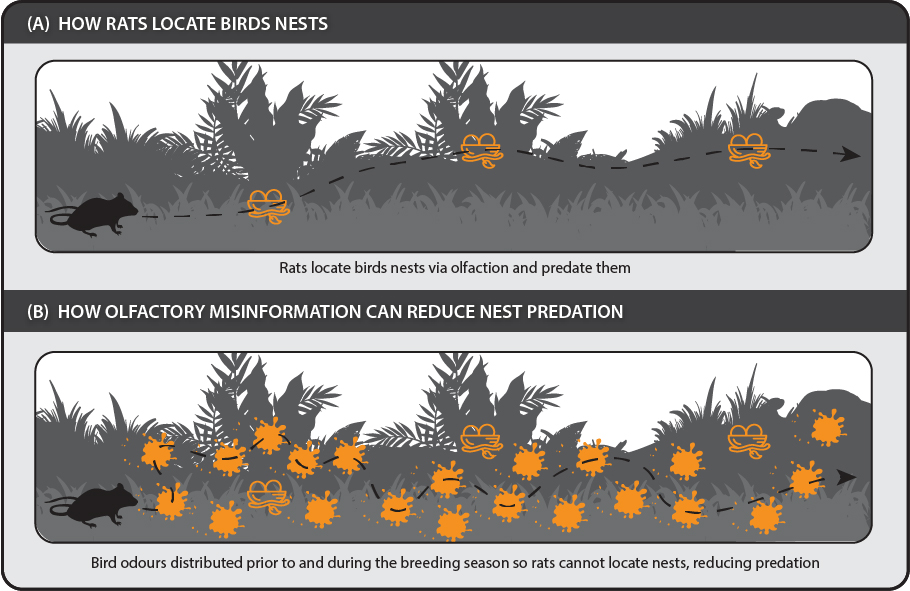
Signalling lies at the heart of behavioural and evolutionary ecology, being the primary means by which animals choose mates and socialise. Yet social signals are open to eavesdropping enemies, including predators which may use prey cues to improve their foraging. Research in our lab focuses on chemical signal exploitation in predator-prey interactions and using chemical camouflage to protect vulnerable species from alien predators. Our research aims to develop a new understanding about the exploitation of social signals by both predator and prey. In doing so we aim to generate new theory on the reactive foraging behaviour of predators and use this theory to solve conservation and agricultural problems.
Funded by:
- Australian Research Council (ARC) Discovery Grant
- Endeavour Grant, New Zealand Ministry of Business, Innovation and Employment
Recent media
- The Conversation (article): Scientists used ‘fake news’ to stop predators killing endangered birds — and the result was remarkable
- The Conversation (podcast): How we created fake smells to trick predators and save endangered birds – podcast
Selected research publications
- Norbury GL, Price CJ, Latham MC, Brown SJ, Latham AD, Brownstein GE, Ricardo HC, McArthur NJ, Banks PB (2021) Misinformation tactics protect rare birds from problem predators. Science Advances 7: eabe4164
- Price CJ & Banks PB (2012) Exploiting olfactory learning in alien rats to protect birds’ eggs. PNAS doi: 10.1073/pnas.1210981109.
- Hughes NK, Kelly JL & Banks PB (2012) Dangerous liaisons: The predation risks of receiving social signals. Ecology Letters 15: 1326-39.
- Banks PB, Daly A & Bytheway JP (2016) Predator odours attract other predators, creating an olfactory web of information. Biology Letters 12: 20151053.
- Hughes NK & Banks PB (2010) Interacting effects of predation risk and signal patchiness on activity and communication in house mice. Journal of Animal Ecology 79: 88-97.
Olfactory misinformation
in agriculture
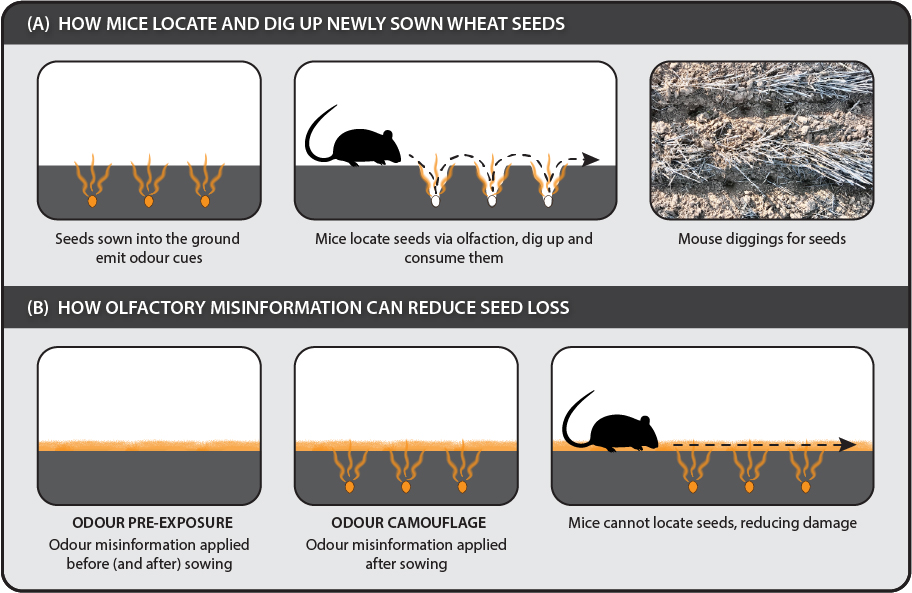
Managing crop damage traditionally relies on poisons to kill pests. But too often poisons don’t reduce pest numbers enough to reduce damage and poisons kill native species and damage ecosystem. We’re using misinformation tactics to simply stop pest animals from finding vulnerable crops at the outset. For example mice can smell the wheat germ of buried wheat seeds and dig them up with great precision. Dispersing wheat germ oil over a newly sown crop prevents the mice from pinpointing where seeds are. Using this approach we reduce mouse damage by up to 73% even during plague conditions without killing a single animal. This new humane approach has great potential to reduce damage by a wide range of agricultural pests and reduce our reliance on toxic chemicals.
Funded by:
- Australian Research Council (ARC) Discovery Grant
Recent media
- The Conversation: How to fool a mouse: ‘chemical camouflage’ can hide crops and cut losses by over 60%
- Science: Scent ‘camouflage’ keeps mice from destroying crops
- Science News: Camouflaging wheat with a wheat smell could be a new approach to pest control
- ABC News (video): Sydney Uni study yields promising results in mice prevention
- 9 News Australia (video): Scientists find clever way to beat mouse plagues hitting farms
- The Sydney Morning Herald: The simple trick to stop another $1 billion mouse plague disaster
Selected research publications
- Parker FCG, Price CJ, Bytheway JP & Banks PB (2023) Olfactory misinformation reduces wheat seed loss caused by rodent pests. Nature Sustainability 6: 1041-1044.
- Price CP, McArthur C, Norbury G & Banks PB (2022) Olfactory misinformation: creating “fake news” to reduce problem foraging by wildlife. Front. Ecol. Environ. 20: 531-538.
- Garvey PM, Banks PB, Suraci JP, Bodey TW, Glen AS, Jones CJ, McArthur C, Norbury GL, Price CJ, Russell JC & Sih A (2020) Leveraging motivations, personality and sensory cues for vertebrate pest management. TREE 35: 990-1000.
- Carthey AJR, Bytheway JP & Banks PB (2011) Negotiating a noisy, information-rich environment in search of cryptic prey: olfactory predators need patchiness in prey cues. J. Anim. Ecol. 80: 742-752.
- Price CP & Banks PB (2016) Increased olfactory search costs change foraging behaviour in an alien mustelid: a precursor to prey switching? Oecologia 182: 119-128.
- Finnerty PB, McArthur C, Banks PB, Price CJ & Shrader AM (2022) The olfactory landscape concept: A key source of past, present, and future information driving animal movement and decision-making. BioScience 72: 745-752.
Behavioural ecology of
alien species
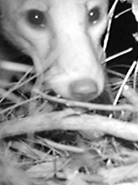
Terrestrial alien predators have proven to be the worst of all invasive species, they are a primary cause of biodiversity and agricultural loss and few ecosystems have escaped their impact. Our research aims to (i) use deception to undermine decision-making by animals in order to better detect and control pest species and curtail their impacts using novel non-lethal techniques; (ii) develop a better understanding of the behavioural and physiological processes which allow alien species to exploit native fauna successfully, with the goal of developing methods to disrupt these processes; (iii) understand the potential bias in wildlife monitoring arising from differing animal personalities within a population; and (iv) investigate density-benefit relationships whereby aliens can perform beneficial ecosystem services.
Funded by:
- Australian Research Council (ARC) Discovery Grant
- Smart Ideas Grant, New Zealand Ministry of Business, Innovation and Employment
- Endeavour Grant, New Zealand Ministry of Business, Innovation and Employment
Selected research publications
- Johnstone KC, McArthur C, Banks PB (2021) Testing transgenerational transfer of personality in managed wildlife populations: a house mouse control experiment. Ecological Applications 31: e02247
- Garvey PM, Banks PB, Suraci JP, Bodey TW, Glen AS, Jones CJ, McArthur C, Norbury GL, Price CJ, Russell JC, Sih A (2020) Leveraging Motivations, Personality, and Sensory Cues for Vertebrate Pest Management. TREE 35: 990-1000
- Hansen N, Hughes NK, Byrom AE & Banks PB (2020) Population recovery of alien black rats Rattus rattus: A test of reinvasion theory. Austral Ecology 45: 291-304 doi: 10.1111/aec.12855.
- Banks PB, Byrom AE, Pech RP & Dickman CR (2018) Reinvasion is not invasion again. BioScience 68: 792-804.
- Smith HM, Dickman CR & Banks PB (2017) Using effect size benchmarks to assess when alien impacts are actually alien. Scientific Reports 7: 38627.
Naiveté in predator-prey
interactions
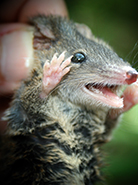
Alien predators have had acute and devastating impacts to our unique wildlife in Australia. Understanding how feral predators affect their prey is a critical conservation objective; not only to identify and protect prey species at risk but also to ensure efficient and targeted management of the problem. Our research focusses on understanding and explaining the role of naiveté in predator-prey interactions and the vulnerability of Australian mammals to alien species.
Funded by:
- Australian Research Council (ARC) Discovery Grant
Selected research publications
- Parker FCG, Price CJ, McArthur C, Bytheway JP & Banks PB (2023) Native predators can learn new prey cues to overcome naivete and hunt novel alien prey. Biological Conservation 284: 110211.
- Banks PB (2021) An eco-evolutionary rationale to distinguish alien and native status: why the dingo is a native species on mainland Australia. Australian Zoologist. 41: 358-366
- Bytheway JP & Banks PB (2019) Overcoming prey naiveté: Free-living marsupials develop recognition and effective behavioural responses to alien predators in Australia. Global Change Biology 25: 1685-1695.
- Banks PB, Carthey AJR & Bytheway JP (2018) Australian native mammals recognize and respond to alien predators: a meta-analysis. Proc. R. Soc. B 285: 20180857.
- Carthey AJR & Banks PB (2014) Naiveté in novel ecological interactions: lessons from theory and experimental evidence. Biological Reviews doi: 10.1111/brv.12087.
- Banks PB & Dickman CR (2007) Alien predation and the effects of multiple levels of prey naiveté. TREE 22: 19-30.
Urban ecology
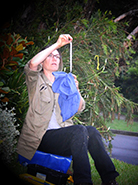
Urbanisation continues to increase at a rapid rate both threatening wildlife and increasing human-wildlife interactions. Research in our group focuses on (i) examining how native mammals are coping with encroaching urbanisation; and (ii) understanding the ecological drivers and role of urban wildlife in human-tick encounters; both with the aim to inform best practice management.
Funded by:
- Hermon Slade Foundation
- Northern Beaches Council
Recent media
- ABC Off Track: Ticked-off in Sydney
Selected research publications
- Taylor CL, Lydecker HW, Lo N, Hochuli DF & Banks PB (2020) Invasive rabbits host immature Ixodes ticks at the urban-forest interface. Ticks and Tick-borne Diseases 11: 101439.
- Wat KKY, Herath APHM, Rus A, Banks PB & McArthur C (2019) Space use by animals on the urban fringe: interactive effects of sex and personality. Behavioral Ecology doi: 10.1093/beheco/arz194.
- Lydecker HW, Hochuli DF & Banks PB (2019) Peri-urban black rats host a rich assembly of ticks and healthier rats have more ticks. Ticks and tick-borne diseases 10: 749- 753.
- Parsons MH, Banks PB, Deutsch MA & Munshi-South J (2018) Temporal and space-use changes by rats in response to predation by feral cat in an urban ecosystem. Frontiers in Ecology & Evolution 6:146.
- Banks PB & Smith HM (2015) The ecological impacts of commensal species: black rats, Rattus rattus, at the urban-bushland interface. Wildlife Research 42: 86-97.


